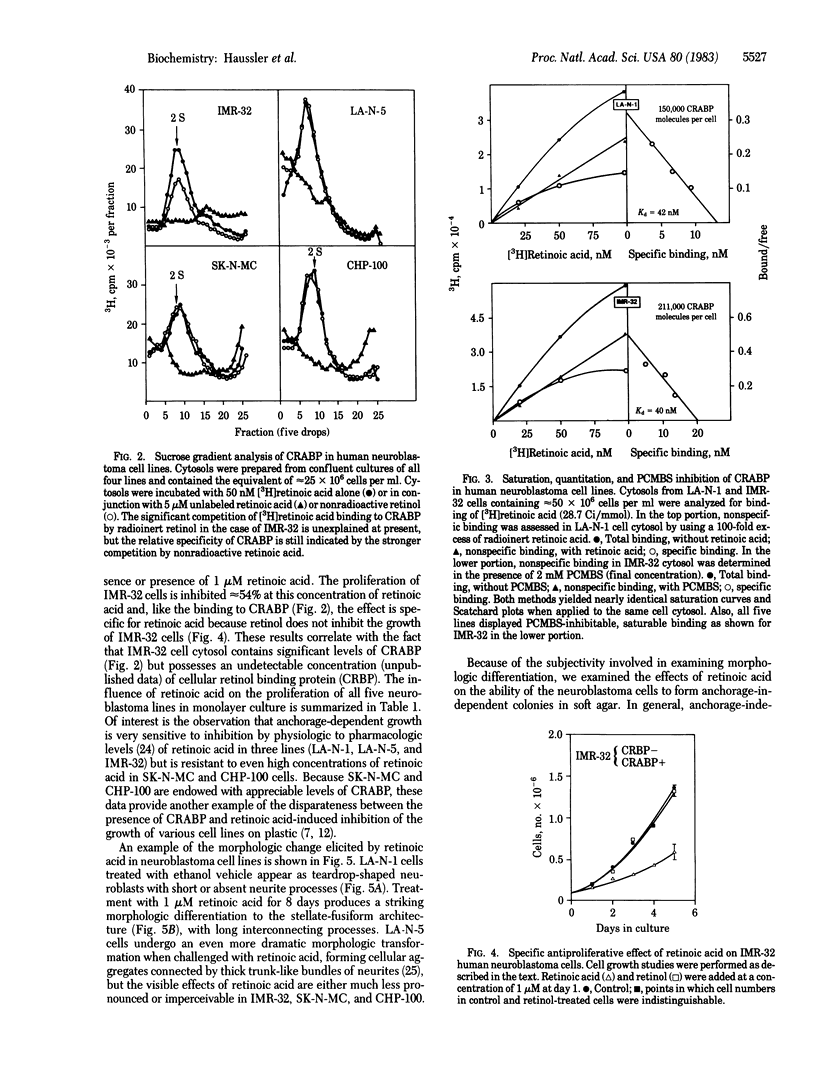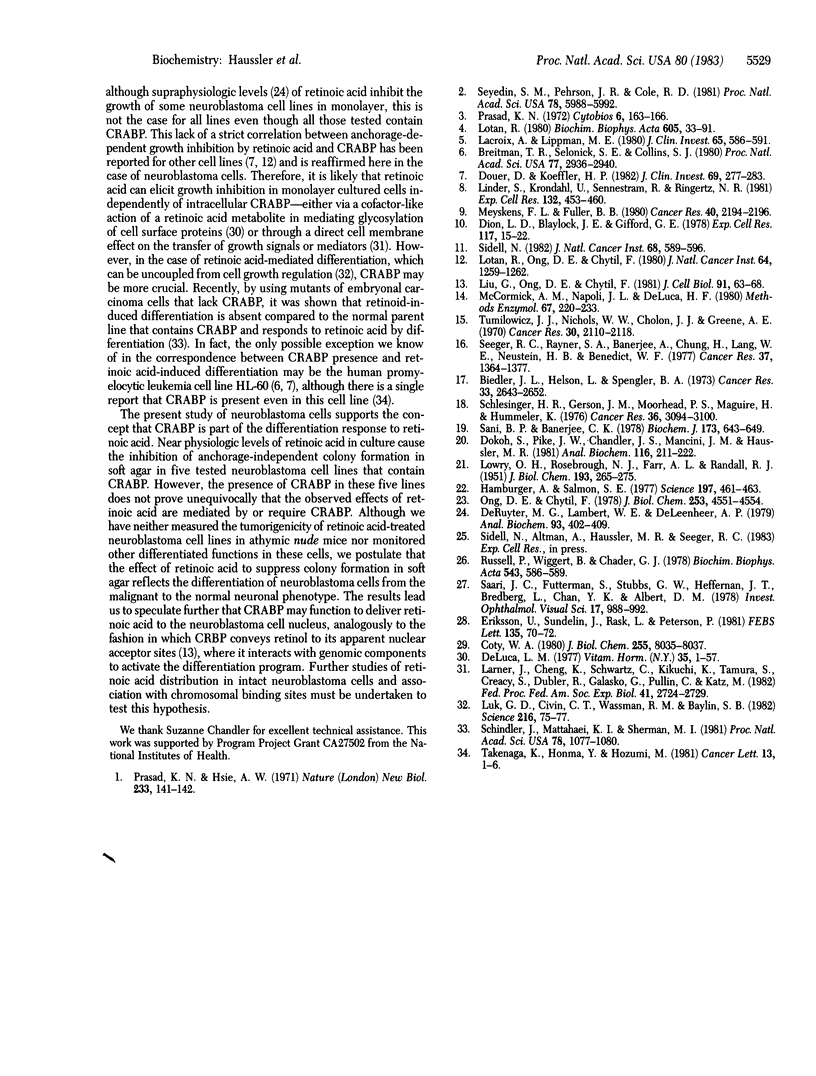Abstract
Neuroblastoma cells are a good model for neuronal development because of their ability to extend neurites in response to various stimuli, including retinoic acid. In the present experiments, we have examined five human neuroblastoma cell lines (LA-N-1, IMR-32, LA-N-5, SK-N-MC, and CHP-100) for the presence of cellular retinoic acid binding protein (CRABP), a receptor-like protein implicated in the molecular functioning of vitamin A. CRABP is identified and quantitated by sucrose gradient centrifugation, selective inhibition by the mercurial reagent p-chloromercuribenzene sulfonic acid (PCMBS), and saturation analysis. All five lines contain significant levels of cytosolic CRABP (2.5-7.5 pmol/mg of protein), which display typical properties of specific high affinity retinoic acid binding, a sedimentation coefficient of 2 S, and inhibition by PCMBS. Three of the lines (LA-N-1, IMR-32, and LA-N-5) are strongly growth inhibited by 1 microM retinoic acid in monolayer culture, whereas two (LA-N-1 and LA-N-5) undergo marked differentiation to a stellate, fusiform morphology with characteristic neurite outgrowths. The SK-N-MC and CHP-100 lines are relatively resistant to the antiproliferative effects of retinoic acid under these conditions. Nevertheless, all five lines are effectively inhibited by retinoic acid in their ability to form anchorage-independent colonies in soft agar. Thus, although CRABP is not necessarily correlated with growth inhibition in monolayer culture, it is associated with retinoic acid's ability to inhibit neuroblastoma colony formation in soft agar. More experiments will be required to determine if this effect on growth in soft agar reflects the putative ability of retinoic acid to convert tumorigenic neuroblastoma cell lines into the normal differentiated phenotype.
Full text
PDF




Images in this article
Selected References
These references are in PubMed. This may not be the complete list of references from this article.
- Biedler J. L., Helson L., Spengler B. A. Morphology and growth, tumorigenicity, and cytogenetics of human neuroblastoma cells in continuous culture. Cancer Res. 1973 Nov;33(11):2643–2652. [PubMed] [Google Scholar]
- Breitman T. R., Selonick S. E., Collins S. J. Induction of differentiation of the human promyelocytic leukemia cell line (HL-60) by retinoic acid. Proc Natl Acad Sci U S A. 1980 May;77(5):2936–2940. doi: 10.1073/pnas.77.5.2936. [DOI] [PMC free article] [PubMed] [Google Scholar]
- Coty W. A. Reversible dissociation of steroid hormone x receptor complexes by mercurial reagents. J Biol Chem. 1980 Sep 10;255(17):8035–8037. [PubMed] [Google Scholar]
- De Ruyter M. G., Lambert W. E., De Leenheer A. P. Retinoic acid: an endogenous compound of human blood. Unequivocal demonstration of endogenous retinoic acid in normal physiological conditions. Anal Biochem. 1979 Oct 1;98(2):402–409. doi: 10.1016/0003-2697(79)90159-3. [DOI] [PubMed] [Google Scholar]
- Dion L. D., Blalock J. E., Gifford G. E. Retinoic acid and the restoration of anchorage dependent growth to transformed mammalian cells. Exp Cell Res. 1978 Nov;117(1):15–22. doi: 10.1016/0014-4827(78)90422-6. [DOI] [PubMed] [Google Scholar]
- Dokoh S., Pike J. W., Chandler J. S., Mancini J. M., Haussler M. R. An improved radioreceptor assay for 1,25-dihydroxyvitamin D in human plasma. Anal Biochem. 1981 Sep 1;116(1):211–222. doi: 10.1016/0003-2697(81)90346-8. [DOI] [PubMed] [Google Scholar]
- Douer D., Koeffler H. P. Retinoic acid. Inhibition of the clonal growth of human myeloid leukemia cells. J Clin Invest. 1982 Feb;69(2):277–283. doi: 10.1172/JCI110450. [DOI] [PMC free article] [PubMed] [Google Scholar]
- Eriksson U., Sundelin J., Rask L., Peterson P. A. The NH2-terminal amino acid sequence of cellular retinoic-acid binding protein from rat testis. FEBS Lett. 1981 Nov 30;135(1):70–72. doi: 10.1016/0014-5793(81)80945-3. [DOI] [PubMed] [Google Scholar]
- Hamburger A. W., Salmon S. E. Primary bioassay of human tumor stem cells. Science. 1977 Jul 29;197(4302):461–463. doi: 10.1126/science.560061. [DOI] [PubMed] [Google Scholar]
- LOWRY O. H., ROSEBROUGH N. J., FARR A. L., RANDALL R. J. Protein measurement with the Folin phenol reagent. J Biol Chem. 1951 Nov;193(1):265–275. [PubMed] [Google Scholar]
- Lacroix A., Lippman M. E. Binding of retinoids to human breast cancer cell lines and their effects on cell growth. J Clin Invest. 1980 Mar;65(3):586–591. doi: 10.1172/JCI109703. [DOI] [PMC free article] [PubMed] [Google Scholar]
- Larner J., Cheng K., Schwartz C., Kikuchi K., Tamura S., Creacy S., Dubler R., Galasko G., Pullin C., Katz M. A proteolytic mechanism for the action of insulin via oligopeptide mediator formation. Fed Proc. 1982 Sep;41(11):2724–2729. [PubMed] [Google Scholar]
- Liau G., Ong D. E., Chytil F. Interaction of the retinol/cellular retinol-binding protein complex with isolated nuclei and nuclear components. J Cell Biol. 1981 Oct;91(1):63–68. doi: 10.1083/jcb.91.1.63. [DOI] [PMC free article] [PubMed] [Google Scholar]
- Linder S., Krondahl U., Sennerstam R., Ringertz N. R. Retinoic acid-induced differentiation of F9 embryonal carcinoma cells. Exp Cell Res. 1981 Apr;132(2):453–460. doi: 10.1016/0014-4827(81)90120-8. [DOI] [PubMed] [Google Scholar]
- Lotan R. Effects of vitamin A and its analogs (retinoids) on normal and neoplastic cells. Biochim Biophys Acta. 1980 Mar 12;605(1):33–91. doi: 10.1016/0304-419x(80)90021-9. [DOI] [PubMed] [Google Scholar]
- Lotan R., Ong D. E., Chytil F. Comparison of the level of cellular retinoid-binding proteins and susceptibility to retinoid-induced growth inhibition of various neoplastic cell lines. J Natl Cancer Inst. 1980 May;64(5):1259–1262. [PubMed] [Google Scholar]
- Luk G. D., Civin C. I., Weissman R. M., Baylin S. B. Ornithine decarboxylase: essential in proliferation but not differentiation of human promyelocytic leukemia cells. Science. 1982 Apr 2;216(4541):75–77. doi: 10.1126/science.6950518. [DOI] [PubMed] [Google Scholar]
- McCormick A. M., Napoli J. L., DeLuca H. F. High-pressure liquid chromatography of vitamin A metabolites and analogs. Methods Enzymol. 1980;67:220–233. doi: 10.1016/s0076-6879(80)67030-x. [DOI] [PubMed] [Google Scholar]
- Meyskens F. L., Jr, Fuller B. B. Characterization of the effects of different retinoids on the growth and differentiation of a human melanoma cell line and selected subclones. Cancer Res. 1980 Jul;40(7):2194–2196. [PubMed] [Google Scholar]
- Ong D. E., Chytil F. Cellular retinoic acid-binding protein from rat testis. Purification and characterization. J Biol Chem. 1978 Jul 10;253(13):4551–4554. [PubMed] [Google Scholar]
- Prasad K. N. Cyclic AMP-induced differentiated mouse neuroblastoma cells lose tumourgenic characteristics. Cytobios. 1972 Nov;6(23):163–166. [PubMed] [Google Scholar]
- Prasad K. N., Hsie A. W. Morphologic differentiation of mouse neuroblastoma cells induced in vitro by dibutyryl adenosine 3':5'-cyclic monophosphate. Nat New Biol. 1971 Sep 29;233(39):141–142. doi: 10.1038/newbio233141a0. [DOI] [PubMed] [Google Scholar]
- Russell P., Wiggert B., Chader G. J. Separation of retinoid receptors from cultured retinoblastoma cells. Biochim Biophys Acta. 1978 Nov 1;543(4):586–589. doi: 10.1016/0304-4165(78)90314-8. [DOI] [PubMed] [Google Scholar]
- Saari J. C., Futterman S., Stubbs G. W., Heffernan J. T., Bredberg L., Chan D. Y., Albert D. M. Cellular retinol- and retinoic acid-binding proteins in transformed mammalian cells. Invest Ophthalmol Vis Sci. 1978 Oct;17(10):988–992. [PubMed] [Google Scholar]
- Sani B. P., Banerjee C. K. Purification and properties of retinoic acid-binding protein from chick-embryo skin. Biochem J. 1978 Aug 1;173(2):643–649. doi: 10.1042/bj1730643. [DOI] [PMC free article] [PubMed] [Google Scholar]
- Schindler J., Matthaei K. I., Sherman M. I. Isolation and characterization of mouse mutant embryonal carcinoma cells which fail to differentiate in response to retinoic acid. Proc Natl Acad Sci U S A. 1981 Feb;78(2):1077–1080. doi: 10.1073/pnas.78.2.1077. [DOI] [PMC free article] [PubMed] [Google Scholar]
- Schlesinger H. R., Gerson J. M., Moorhead P. S., Maguire H., Hummeler K. Establishment and characterization of human neuroblastoma cell lines. Cancer Res. 1976 Sep;36(9 PT1):3094–3100. [PubMed] [Google Scholar]
- Seeger R. C., Rayner S. A., Banerjee A., Chung H., Laug W. E., Neustein H. B., Benedict W. F. Morphology, growth, chromosomal pattern and fibrinolytic activity of two new human neuroblastoma cell lines. Cancer Res. 1977 May;37(5):1364–1371. [PubMed] [Google Scholar]
- Seyedin S. M., Pehrson J. R., Cole R. D. Loss of chromosomal high mobility group proteins HMG1 and HMG2 when mouse neuroblastoma and Friend erythroleukemia cells become committed to differentiation. Proc Natl Acad Sci U S A. 1981 Oct;78(10):5988–5992. doi: 10.1073/pnas.78.10.5988. [DOI] [PMC free article] [PubMed] [Google Scholar]
- Sidell N. Retinoic acid-induced growth inhibition and morphologic differentiation of human neuroblastoma cells in vitro. J Natl Cancer Inst. 1982 Apr;68(4):589–596. [PubMed] [Google Scholar]
- Takenaga K., Honma Y., Hozumi M. Cellular retinoid-binding proteins in cultured human and mouse myeloid leukemia cells. Cancer Lett. 1981 Jun;13(1):1–6. doi: 10.1016/0304-3835(81)90079-3. [DOI] [PubMed] [Google Scholar]
- Tumilowicz J. J., Nichols W. W., Cholon J. J., Greene A. E. Definition of a continuous human cell line derived from neuroblastoma. Cancer Res. 1970 Aug;30(8):2110–2118. [PubMed] [Google Scholar]



